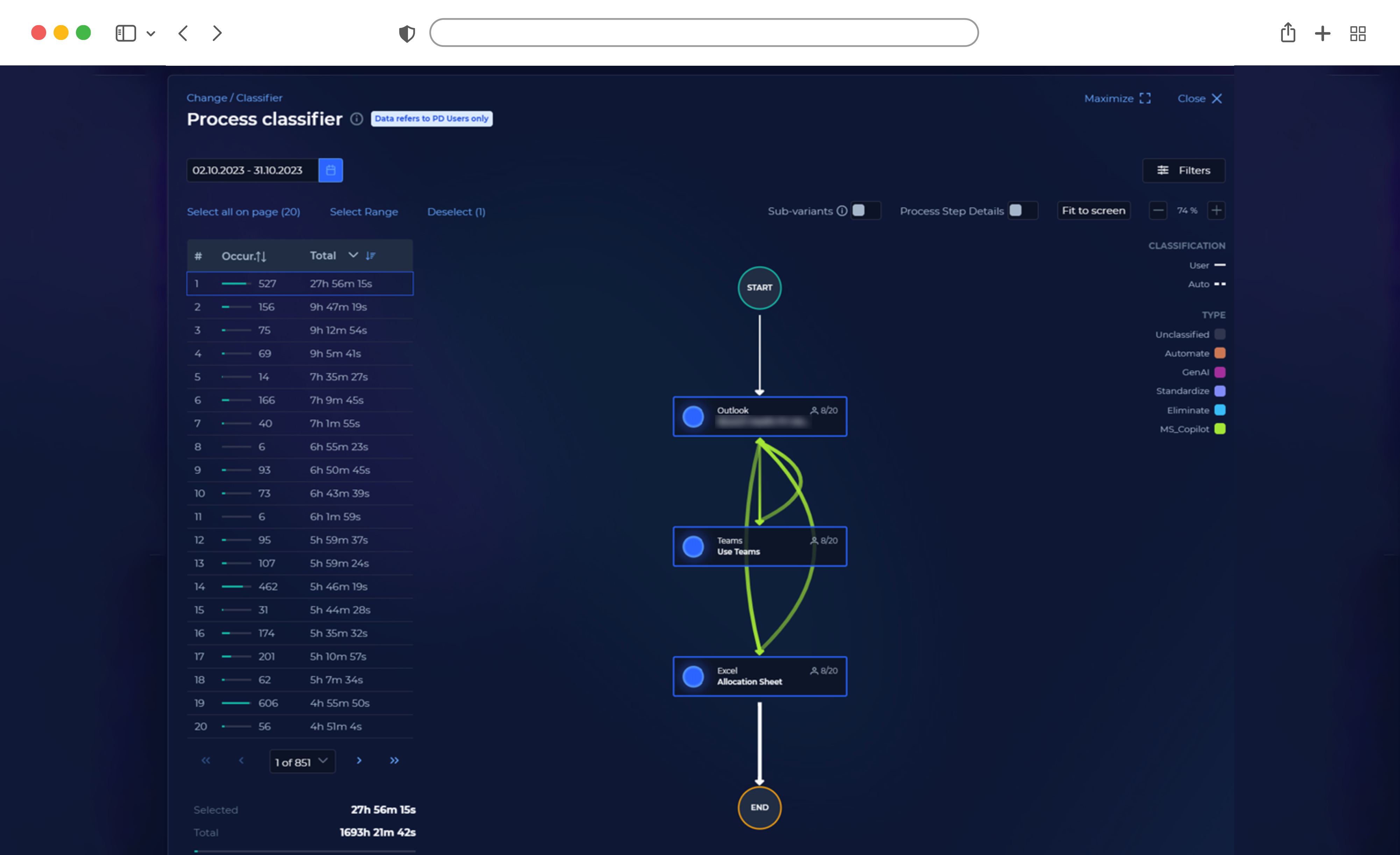Businesses increasingly rely on data analytics for operational excellence in the digital transformation era. Productivity and process mining software have become indispensable tools in this journey.
Productivity mining takes a holistic approach, optimising overall resource use and enterprise productivity by analysing various operational elements. At the same time, process mining focuses on detailed analysis of users’ activities, data flows, and event logs to improve the efficiency and transparency of specific business processes.
The choice between these tools depends on an organisation’s needs. Productivity mining suits enterprises aiming for broad operational changes, enhancing customer-centricity, and fostering a culture of continuous improvement. Process mining is more apt for established businesses seeking to refine existing processes with thorough data analysis. Understanding these differences helps companies to make informed choices for their digital strategies, combining the strengths of both approaches to achieve operational excellence.
Unveiling the Essence: Productivity Mining Software
Productivity mining software is a strategic asset that offers a holistic analysis of processes, people, and technology, identifying inefficiencies and turning data into actionable insights.
This approach differs from traditional analytics by focusing on interconnected elements that drive productivity, fostering a culture of continuous improvement. It leverages advanced techniques like machine learning (ML) and advanced data engineering to analyse operational data comprehensively, providing visibility into every aspect of enterprise operations.
The software shifts the focus from isolated metrics to a broader view, enabling strategies for wide-scale transformation and operational excellence. It serves as a convergence point for workflow dynamics, human talent, and technology, enabling optimisation at scale and pioneering a new frontier in data-driven decision-making.
Embracing the Tradition: Process Mining Software
Process mining software is vital for operational efficiency, offering detailed analysis of users’ activities and underlying event log data to optimise business processes. It accurately identifies variants being carried out, pointing out automation cases and inefficiencies, enabling targeted improvements and waste reduction.
This software goes beyond traditional analytics by providing granular insights into each step of a process. It maps and analyses workflows based on event data, pinpointing improvement areas and quantifying the impact of deviations. The level of detail is crucial for drilling into complex legacy processes, revealing opportunities for incremental enhancements that collectively yield substantial benefits.
Process mining thus becomes an essential tool in an operational excellence strategy, offering a clear view into the intricacies of enterprise operations and guiding continuous improvement through data-driven insights.
A Holistic Lens: How Productivity Mining Software Elevates Enterprises
Productivity mining software offers a comprehensive, eagle’s eye view of the business processes in organisations. It analyses the interplay of processes, people, and technology, providing insights for informed decision-making and optimal resource utilisation. This software aligns human efforts with technological capabilities, enhancing productivity and supporting a sustainable operational model.
By providing a 360-degree view of operations, productivity mining software helps enterprises pivot towards customer-centricity, aligning operational elements with customer satisfaction to improve experiences and loyalty. It deconstructs operations to highlight optimisation pathways, targeting factors that hinder productivity. This facilitates the strategic realignment of resources, enabling efficient pairing of human talent with processes and technology.

This holistic approach not only rectifies bottlenecks but also inspires broad initiatives for digital transformation. Productivity mining software is essential for leaders seeking to navigate the data-driven landscape of operational excellence, offering a lens to master the combination of components driving productivity.
The Core Focus: Process Mining Software’s Influence on Operations
Process mining software significantly influences enterprise operations by offering detailed insights into workflows, turning complexity into simplicity. It reconstructs processes from applicational events data, providing transparency and highlighting improvement areas to streamline complex procedures. This analytical approach transforms chaotic workflows into orderly, end-to-end flow charts, making inefficiencies visible and actionable.
The software enhances efficiency by providing data-driven insights for process optimisation, leading to faster cycles, fewer errors, and cost reductions. These benefits are evident across various industries. In finance, it streamlines customer onboarding and credit risk analysis. In manufacturing, it refines production and supply chain logistics. In healthcare, it improves care cycle efficiency and patient satisfaction.
Process mining software’s ability to bring clarity and order to operational processes makes it an indispensable tool for enterprises aiming to enhance efficiency. It has proven its value in driving operational improvements, making it a critical asset for any business seeking to optimise and streamline its workflows.
Choosing the Right Fit: Factors in Selecting Between Approaches
Selecting between productivity and process mining software hinges on aligning your enterprise’s unique needs with the capabilities of each software type. Key factors include organisational objectives, digital infrastructure, scalability, and adaptability.
Organisational goals are crucial in this decision. Productivity mining suits enterprises aiming for broad operational changes, focusing on customer-centricity, resource optimisation, and continuous improvement. In contrast, process mining is ideal for refining specific workflows and improving legacy processes.
The existing digital infrastructure also influences the choice. Productivity mining fits well with cloud or hybrid-based, agile data environments, while process mining is more suited to on-premise systems with structured flows and event logs. Choosing a software suite that adequately combines both approaches by diligently collecting data at the users’ workstations and then smartly combining it for deep insights provides an organisation with the most complete and valuable perspective on its operations.
Scalability needs are another consideration. Productivity mining scales across various operational areas, while process mining delves deep into specific workflow intricacies. The choice depends on whether the organisation seeks broad or targeted enhancements. Again, multifaceted software combining the best of these two approaches is highly beneficial for organisations.
Ease of use and adaptability also matter. Productivity mining typically offers user-friendly interfaces for business users, whereas process mining might require more technical expertise to interpret complex data visualisations. The desired direction for companies would be software that provides well-designed navigation into operational activities overview, breakdown into people, processes, and technologies, and finally, valuable recommendations for process optimisations and automation.
Careful evaluation of these factors ensures the selected software aligns with the enterprise’s strategic vision and operational requirements, paving the way for transformative success in data-driven endeavours.
Case Studies: Comparing Successes with Productivity and Process Mining Software
By adopting the right software, organisations can achieve tangible success, and there are three relevant examples to prove it. Let’s take a closer look at these cases and the underpinning benefits.
Azimo’s use of productivity mining software and Alliance Healthcare’s application of process mining software demonstrate their impact on enterprise transformation and optimisation. Azimo, a fintech company, used productivity mining to manage its rapid global customer base growth without significantly scaling up resources. This approach provided insights across customer onboarding, workforce, and technical systems, enabling a 4X growth in their customer base. Productivity mining helped Azimo identify synergies between different operational areas, facilitating integrated scaling strategies that grew operations without proportionate investments. This case exemplifies the versatility of productivity mining in enabling holistic transformation.
Alliance Healthcare, on the other hand, faced inefficiencies in its supply chain. They reconstructed their order-to-cash workflow through process mining, identifying and eliminating over 60% of unnecessary steps. This led to a 62% reduction in order touchpoints and $4.3 million in annual savings, showcasing the efficacy of process mining in driving detailed workflow optimisations.

Adding to these examples is the experience of a global agri-business shared service centre, which faced the shift to a hybrid work model while aiming to maintain service quality. Implementing KYP.ai, a multi-faceted productivity platform, they achieved real-time visibility into their workforce’s activities, which was crucial in a work-from-home scenario.
The software’s capabilities in value-stream-mapping and the SOAR (Standardise, Optimise, Automate, Replicate) principle led to a 12% increase in productivity by addressing over 600+ processes handled by more than 1000 agents. The increase in the engagement rate of leaders with their workforce also fostered better collaboration and work-life balance, showcasing productivity mining software’s capacity to optimise operations and enhance employee well-being in a complex, hybrid work environment.
These case studies illustrate the distinct advantages of process productivity software. Productivity mining supports agile scaling and holistic growth, while process mining focuses on detailed, process-level improvements, offering tailored solutions based on an enterprise’s strategic needs. Each case demonstrates how such advanced software types can lead to significant organisational improvements through rapid scaling, process efficiency, or adaptation to new work models.
The Confluence of Insights: Future of Enterprise Process Mining Software
The future of enterprise process mining software lies in integrating productivity and process mining tools. This convergence, fuelled by technological advancements like AI/ML and intelligent identification of automation scenarios like GenAI, creates platforms that blend comprehensive productivity analytics with precise process insights. KYP.ai, the software mentioned above, combines such approaches, providing a robust way for organisational transformations.
Such advanced solutions combine broad operational analytics with targeted workflow improvements, providing a holistic view of organisational operations. This integration allows for a more thorough understanding of how various facets of an organisation interconnect, facilitating more effective refinement and optimisation strategies.
Innovations are already linking process mining with areas like customer journey analytics, resource planning, and predictive modelling. This evolution heralds a new era of process analytics, capable of leveraging data interconnections for more nuanced insights.
The future envisions an integrated command centre for enterprises, enabling the simulation of improvement scenarios across processes, people, and technology. Such a unified approach will be critical for orchestrating comprehensive transformations and optimisations.
As digital maturity grows, this integrated perspective of combining multidimensional productivity insights with process analytics will become essential for process excellence. This holistic approach holds immense potential for unlocking value and elevating enterprise optimisation to unprecedented levels.
Conclusion
Investing in the right productivity and process mining software empowers organizations to unlock the true potential of their data.
This software acts as a versatile companion, adapting to your immediate operational needs while simultaneously supporting your long-term strategic vision. Ease of use and powerful performance combine to deliver tangible value, propelling your organization towards enhanced operational efficiency and holistic growth.
Remember, in the digital era, leveraging data is the cornerstone of success.
Harness the holistic view offered by productivity mining, identifying the perfect synergy between processes, people, and technology. Leverage the precision of process mining, pinpointing inefficiencies and paving the way for targeted improvement.
The key lies in finding software that seamlessly blends these functionalities. By choosing the ideal platform, you gain access to a wealth of data-driven insights, empowering you to:
- Optimize operational efficiency: Eliminate waste and streamline workflows for a leaner, more productive organization.
- Fuel continuous improvement: Gain a clear understanding of your processes and identify areas for continuous optimization.
- Navigate strategic growth: Leverage data-driven insights to inform strategic decision-making and achieve long-term goals.
Don’t settle for surviving in the digital age – choose the right software and unlock the power to thrive.
 Sarah Burnett
Sarah Burnett 